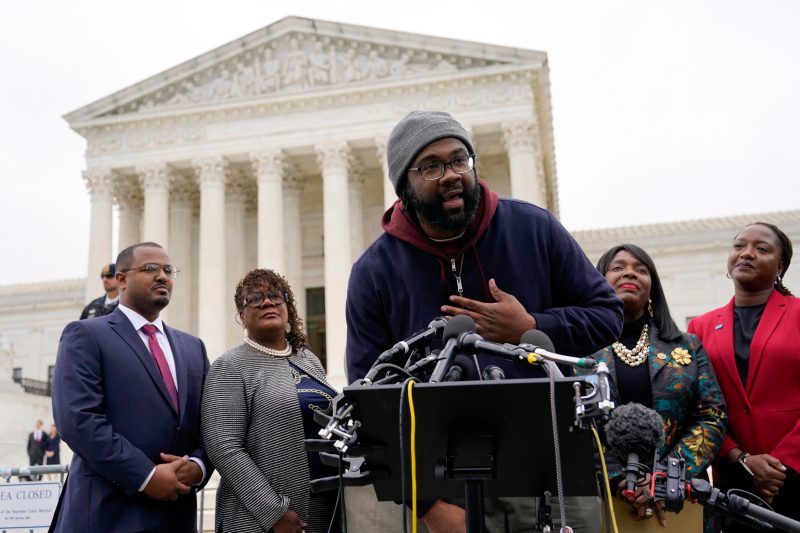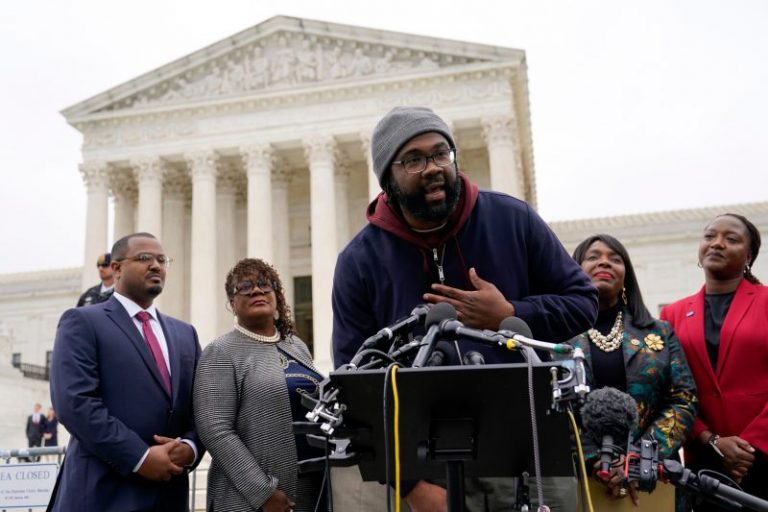
A Supreme Court decision Thursday on redistricting delivered Democrats an unexpected jolt of energy headed into next year’s congressional races, offering a path to pick up additional House seats — perhaps enough to alter the balance of power in the narrowly divided body.
Democrats need to win five or more seats to overtake the majority that Republicans claimed last year, and Thursday’s ruling will probably give them two to four more seats following the 2024 election, according to the nonpartisan Cook Political Report.
In Thursday’s 5-4 decision, the justices ruled against an Alabama congressional map that included just one district with a majority of Black voters, requiring the drawing of a new map in that state. The decision is also expected to ripple through other Southern states with large concentrations of Black Democratic voters where civil rights groups say minority communities have long been underrepresented.
“There are minor developments and then there are game changers. I think this falls into the game changer category,” said David Wasserman, the senior House editor of the Cook Political Report.
He said Democrats are certain to get an additional seat in Alabama and another in Louisiana that strongly favor their candidates. They also have a shot at winning additional seats in Georgia and South Carolina, he said. Democrats said Thursday’s ruling would also give them a chance to make a play for more seats in Texas, but Wasserman said he was skeptical of their prospects.
Thursday’s ruling affirmed the test that courts have used for years regarding “majority-minority” districts, and it will affect a small number of the House’s 435 seats. But with margins as tight as they are, even a minor change could have a dramatic effect on who controls Congress next year.
Less than two months ago, the North Carolina Supreme Court handed Democrats a setback by giving Republican state lawmakers a free hand to draw a map that significantly helps their party. Republicans there were set to gain five seats but now may be able to draw themselves just three or four more, Wasserman said.
Rep. Suzan DelBene (D-Wash.), the chairwoman of the Democratic Congressional Campaign Committee, said the ruling would help Democrats take control of the House, characterizing it as “a monumental decision and a big victory for democracy and a victory for communities of color.”
Jack Pandol, a spokesman for the National Republican Congressional Committee, accused Democrats of engaging in a political strategy to “sue ‘til it’s blue.” He contended that Republicans would capitalize on unpopular Democratic policies to expand their majority.
President Biden praised the decision, calling on Congress to strengthen the Voting Rights Act and ban partisan gerrymandering.
“The right to vote and have that vote counted is sacred and fundamental — it is the right from which all of our other rights spring,” he said in a written statement. “Key to that right is ensuring that voters pick their elected officials — not the other way around. Today’s decision confirms the basic principle that voting practices should not discriminate on account of race, but our work is not done.”
The ruling was a rare victory for Democrats from a court that has tended to side with Republicans in redistricting and voting rights cases. Nicholas Stephanopoulos, a professor of election law at Harvard Law School, called the ruling “a truly, truly stunning development” and “the most unexpected voting rights development” in 30 years.
“It’s an incredibly dramatic result all around,” he said. “We’re now going to see the creation of an additional Black opportunity district in Alabama. I think we’re also now going to see the same result in Louisiana and maybe in other Southern states like South Carolina, Georgia and Florida.”
States every decade must draw new districts based on U.S. census data to ensure districts have equal populations. Where the lines go has a tremendous effect on which political party has an advantage in elections. To varying degrees, state lawmakers around the country have used redistricting to carve up maps in ways that help their side.
In Thursday’s decision, the court said states must follow rules laid out in past cases to ensure that areas with a high concentration of minority voters have a chance to elect a candidate of their choice.
Voters in Alabama who sued the state argued that many of Alabama’s Black voters were packed into one district, with the rest dispersed across other districts to diminish their voting power. A three-judge panel unanimously ruled in their favor, finding the state needed a second district in which minority voters had the opportunity to elect a candidate of their choice.
The Supreme Court allowed Alabama to use the map drawn by state lawmakers for last year’s election while the justices considered the case. With Thursday’s ruling, a new map will be required.
Abha Khanna, the partner at Elias Law Group who argued the case before the Supreme Court, said she was thrilled with the ruling because it ensures that districts in Black communities are drawn as they were intended under a crucial provision of the Voting Rights Act known as Section 2.
“I’m most hopeful that because of this decision states like Alabama won’t wait for the next lawsuit and won’t fight when the writing’s on the wall,” Khanna said. “Let’s just all agree to play the game under the rules as we all know them rather than trying to change the rules.”
John Wahl, the chairman of the Alabama Republican Party, in a statement expressed disappointment in the decision but said the state party “remains committed to competing in every district.”
Alabama has five White Republican representatives and one Black Democratic representative. More than a quarter of the population in the state is Black. In South Carolina, where a similar percentage of the population is Black, the seven-member delegation has one Black Democrat and six White Republicans.
Louisiana is another state where the ruling is expected to have an immediate impact. The state is represented by five White Republicans and one Black Democrat. A third of the state’s population is Black, according to the census.
Katie Bernhardt, chairwoman of the Louisiana Democratic Party, said she learned of the Supreme Court ruling Thursday when her phone was suddenly “bombarded with messages.”
“Obviously we’re cautiously optimistic and this is a big deal,” Bernhardt said. “This could give us a real shot at fair representation.”
Bernhardt said the map produced by Louisiana’s Republican legislature effectively silences a large swath of Black voters — most egregiously, she said, by lumping the New Orleans and Baton Rouge metro areas into one skinny, snaking district.
“That I think is a clear violation of the Voting Rights Act,” Bernhardt said. “It’s to me outrageous that New Orleans is the only area of our state where we [Democrats] have representation. The Baton Rouge metro area is arguably the largest population in the state now and a majority-minority population, so that’s one that I can see being redrawn.”
Spencer Overton, a professor at George Washington University Law School, said the ruling is significant but may not be long-lasting.
“The consequences of today’s case are so much bigger than whether there will be one more Black member of Congress,” Overton said. “My concern, though, is that this was a narrow victory.”
Those who oppose the decision may find ways to get the issue back to the Supreme Court with arguments that will appeal to the conservatives who control the court, he said.
Marina Jenkins, the executive director of the National Democratic Redistricting Committee, said the ruling was likely to result in the creation of three additional seats that Democrats would be favored to win: one in Alabama, one in Louisiana and one in Georgia.
The ruling could also have an impact in Texas, where Jenkins said it “clears a path” for Voting Rights Act suits to prevail that could result in Democrats gaining three to five more seats.
Republicans disputed that the ruling would necessarily result in Alabama’s congressional map changing enough to assure Democrats of picking up a seat there, let alone seats in other states.
“Today’s opinion maintains an indecipherable status quo,” Adam Kincaid, the president and executive director of the National Republican Redistricting Trust, said in a written statement. “The Supreme Court needs to clarify two decades of contradictory precedent on how redistricting plans can comply with both [Section 2 of the Voting Rights Act] and the Constitution.”
Amy B Wang, Theodoric Meyer and Robert Barnes contributed to this report.


Comments are closed.